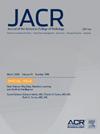Association of Scholarly Impact to Industrial Contributions Among Academic Interventional Radiologists
IF 4
3区 医学
Q1 RADIOLOGY, NUCLEAR MEDICINE & MEDICAL IMAGING
引用次数: 0
Abstract
Objective
The Physician Sunshine Act of 2010 aimed to increase public awareness of physician-industry relationships. Our objective was to evaluate whether there is an association between scholarly impact and industry funding among academic interventional radiologists.
Methods
A database from a prior study with our group was used in which we had investigated H-indices among US interventional radiologists; academic rank, gender, institution, and geographic location were obtained. The Scopus database was queried to determine all physicians’ H-index. The CMS Open Payments database was used to determine industry payments from 2015 to 2021 for each interventional radiologist.
Results
H-index and professor rank positively and significantly correlated with industrial funding (H-index coefficient = $6,977, P < .001 and professor rank coefficient = $183,902, P = .003). Industry funding was found to be significantly different between all ranks. Among 830 academic interventional radiologists, the mean industrial funding of male physicians was $130,034, which was significantly higher than female physicians’ $28,166 (P = .00013). By academic rank, male primary investigators of associate professor and unranked position had higher industrial funding than female primary investigators (Wilcoxon test, P = .029 and P= .039, respectively). Professor and assistant professor ranks had no significant difference in industrial funding between male and female physicians (Wilcoxon’s test, P = .080 and P = .053, respectively).
Conclusion
Scholarly activity as defined by the H-index and academic rank seem to have a positive association with industry funding of academic interventional radiologists.
学术介入放射科医生的学术影响力与行业贡献之间的关联。
目的:2010 年《医生阳光法案》旨在提高公众对医生与行业关系的认识。我们的目的是评估学术介入放射医师的学术影响力与行业资助之间是否存在关联:我们使用了我们小组之前研究的一个数据库,在该数据库中我们调查了美国介入放射科医生的 H 指数;并获得了学术排名、性别、机构和地理位置。我们查询了 Scopus 数据库,以确定所有医生的 H 指数。利用 CMS Open Payments 数据库确定了每位介入放射科医生 2015 年至 2021 年的行业薪酬:H指数和教授级别与行业资助呈显著正相关(H指数系数=6,977美元,P < .001;教授级别系数=183,902美元,P = .003)。所有级别之间的行业资助均有明显差异。在 830 名学术介入放射科医生中,男性医生的平均行业资助为 130,034 美元,明显高于女性医生的 28,166 美元(P = .00013)。按学术职级划分,副教授和无职级的男性主要研究人员的行业资助高于女性主要研究人员(Wilcoxon 检验,P = .029 和 P= .039)。教授和助理教授级别的男女医生在工业资助方面没有显著差异(Wilcoxon 检验,P = .080 和 P = .053):结论:由 H 指数和学术级别定义的学术活动似乎与介入放射科医师的行业资助有积极的联系。
本文章由计算机程序翻译,如有差异,请以英文原文为准。
求助全文
约1分钟内获得全文
求助全文
来源期刊

Journal of the American College of Radiology
RADIOLOGY, NUCLEAR MEDICINE & MEDICAL IMAGING-
CiteScore
6.30
自引率
8.90%
发文量
312
审稿时长
34 days
期刊介绍:
The official journal of the American College of Radiology, JACR informs its readers of timely, pertinent, and important topics affecting the practice of diagnostic radiologists, interventional radiologists, medical physicists, and radiation oncologists. In so doing, JACR improves their practices and helps optimize their role in the health care system. By providing a forum for informative, well-written articles on health policy, clinical practice, practice management, data science, and education, JACR engages readers in a dialogue that ultimately benefits patient care.
 求助内容:
求助内容: 应助结果提醒方式:
应助结果提醒方式:


